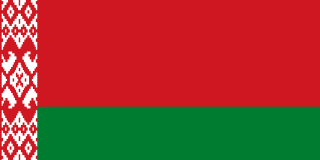
Belarus, officially the Republic of Belarus, is a landlocked country in Eastern Europe. It is bordered by Russia to the east and northeast, Ukraine to the south, Poland to the west, and Lithuania and Latvia to the northwest. Belarus spans an area of 207,600 square kilometres (80,200 sq mi) with a population of 9.1 million. The country has a hemiboreal climate and is administratively divided into six regions. Minsk is the capital and largest city; it is administered separately as a city with special status.

Vilnius is the capital of and largest city in Lithuania and the most-populous city in the Baltic states. The city's estimated January 2025 population was 607,404, and the Vilnius urban area has an estimated population of 747,864.
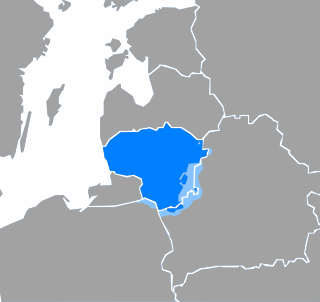
Lithuanian is an East Baltic language belonging to the Baltic branch of the Indo-European language family. It is the language of Lithuanians and the official language of Lithuania as well as one of the official languages of the European Union. There are approximately 2.8 million native Lithuanian speakers in Lithuania and about 1 million speakers elsewhere. Around half a million inhabitants of Lithuania of non-Lithuanian background speak Lithuanian daily as a second language.

Kaunas is the second-largest city in Lithuania after Vilnius, the fourth largest city in the Baltic States and an important centre of Lithuanian economic, academic, and cultural life. Kaunas was the largest city and the centre of a county in the Duchy of Trakai of the Grand Duchy of Lithuania and Trakai Palatinate since 1413. In the Russian Empire, it was the capital of the Kaunas Governorate from 1843 to 1915.

The Baltic states or the Baltic countries is a geopolitical term encompassing Estonia, Latvia, and Lithuania. All three countries are members of NATO, the European Union, the Eurozone, Council of Europe, and the OECD. The three sovereign states on the eastern coast of the Baltic Sea are sometimes referred to as the "Baltic nations", less often and in historical circumstances also as the "Baltic republics", the "Baltic lands", or simply the Baltics. The term Balticum is sometimes used to describe the region comprising the three states.

Romuva is a neo-pagan movement derived from the traditional mythology of the Lithuanians, attempting to reconstruct the religious rituals of the Lithuanians before their Christianization in 1387. Practitioners of Romuva claim to continue Baltic pagan traditions which survived in folklore, customs and superstition. Romuva is a polytheistic pagan faith which asserts the sanctity of nature and ancestor worship. Practicing the Romuva faith is seen by many adherents as a form of cultural pride, along with celebrating traditional forms of art, retelling Baltic folklore, practicing traditional holidays, playing traditional Baltic music, singing traditional dainos (songs), as well as ecological activism and stewarding sacred places.

The Grand Duchy of Lithuania was a sovereign state in northeastern Europe that existed from the 13th century, succeeding the Kingdom of Lithuania, to the late 18th century, when the territory was suppressed during the 1795 partitions of Poland–Lithuania. The state was founded by Lithuanians, who were at the time a polytheistic nation of several united Baltic tribes from Aukštaitija. By 1440 the grand duchy had become the largest European state, controlling an area from the Baltic Sea in the north to the Black Sea in the south.
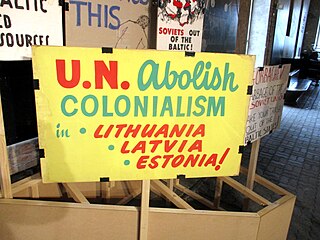
The occupation of the Baltic states was a period of annexation of Estonia, Latvia and Lithuania by the Soviet Union from 1940 until its dissolution in 1991. For a brief period, Nazi Germany occupied the Baltic states after it invaded the Soviet Union in 1941.

The prime minister of Lithuania is the head of government of Lithuania. The prime minister is appointed by the president with the assent of the Lithuanian parliament, the Seimas. The modern office of prime minister was established in 1990, when Lithuania declared its independence, although the official title was "Chairperson of the Council of Ministers" until 25 November 1992.

"Tautiška giesmė" or "Lietuvos himnas", also known by its incipit "Lietuva, Tėvyne mūsų", is the national anthem of Lithuania. The music and lyrics were written in 1898 by Vincas Kudirka, when Lithuania was still part of the Russian Empire. The fifty-word poem was a condensation of Kudirka's conceptions of the Lithuanian state, the Lithuanian people, and their past. Shortly before his death in 1899, the anthem was performed for Lithuanians living in Saint Petersburg, Russia.
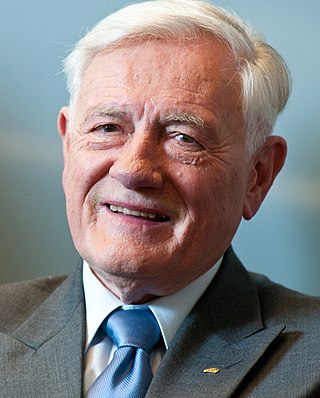
Valdas Adamkus is a Lithuanian politician, diplomat and civil engineer who served as the fifth and seventh president of Lithuania from 1998 to 2003 and again from 2004 to 2009.

The Klaipėda Region or Memel Territory was defined by the 1919 Treaty of Versailles in 1920 and refers to the northernmost part of the German province of East Prussia, when, as Memelland, it was put under the administration of the Entente's Council of Ambassadors. The Memel Territory, together with other areas severed from Germany, was to remain under the control of the League of Nations until a future date, when the people of these regions would be allowed to vote on whether the land would return to Germany or not. Today, the former Memel Territory is controlled by Lithuania as part of Klaipėda and Tauragė counties.
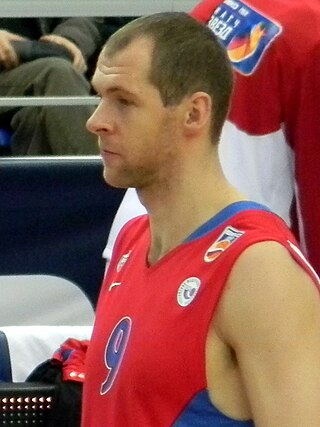
Ramūnas Šiškauskas is a former Lithuanian professional basketball player and basketball coach. Listed at 1.98 m tall, he could play at both the shooting guard and small forward positions. His individual accolades as a player include a EuroLeague MVP award, four All-EuroLeague Team selections, as well as an All-EuroBasket Team designation. On May 16, 2014, Šiškauskas was named a EuroLeague Legend.
Lithuania participated in the Eurovision Song Contest 2007 with the song "Love or Leave" written by Julija Ritčik. The song was performed by the band 4Fun. The Lithuanian broadcaster Lithuanian National Radio and Television (LRT) organised the national final "Eurovizijos" dainų konkurso nacionalinė atranka in order to select the Lithuanian entry for the 2007 contest in Helsinki, Finland. The national final took place over six weeks and involved three different competitive streams: entries performed by newcomers, semi-established artists and established artists. In the final, eleven artists and songs remained and the winner was selected over two rounds of public voting. In the first round, the top three were selected to qualify to the superfinal. In the superfinal, "Love or Leave" performed by 4Fun was selected as the winner with 23,888 votes.
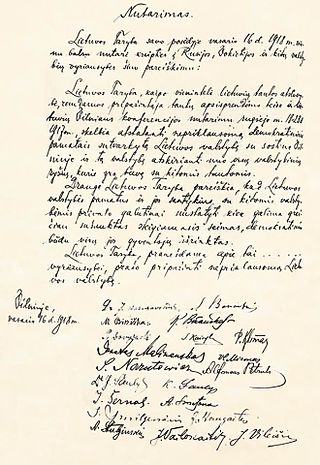
The Act of Independence of Lithuania or the Act of February 16th, also the Lithuanian Resolution on Independence, was signed by the Council of Lithuania on February 16, 1918, proclaiming the restoration of an independent State of Lithuania, governed by democratic principles, with Vilnius as its capital. The Act was signed by all twenty representatives of the Council, which was chaired by Jonas Basanavičius. The Act of February 16 was the result of a series of resolutions on the issue, including one issued by the Vilnius Conference and the Act of January 8. The path to the Act was long and complex because the German Empire exerted pressure on the Council to form an alliance. The Council had to carefully maneuver between the Germans, whose troops were present in Lithuania, and the demands of the Lithuanian people.
The Lithuanian National Revival, alternatively the Lithuanian National Awakening or Lithuanian nationalism, was a period of the history of Lithuania in the 19th century, when a major part of Lithuanian-inhabited areas belonged to the Russian Empire. It was expressed by the rise of self-determination of the Lithuanians that led to the formation of the modern Lithuanian nation and culminated in the re-establishment of an independent Lithuanian state. The most active participants of the national revival included Vincas Kudirka and Jonas Basanavičius. The period largely corresponded to the rise of romantic nationalism and other national revivals of 19th-century Europe.

The Holocaust resulted in the near total eradication of Lithuanian (Litvaks) and Polish Jews[a] in Generalbezirk Litauen of the Reichskommissariat Ostland in the Nazi-controlled Lithuania. Of approximately 208,000–210,000 Jews at the time of the Nazi invasion, an estimated 190,000 to 195,000 were killed before the end of World War II, most of them between June and December 1941. More than 95% of Lithuania's Jewish population was murdered over the three-year German occupation, a more complete destruction than befell any other country in the Holocaust. Historians attribute this to the massive collaboration in the genocide by the non-Jewish local paramilitaries, though the reasons for this collaboration are still debated. The Holocaust resulted in the largest loss of life in so short a period of time in the history of Lithuania.
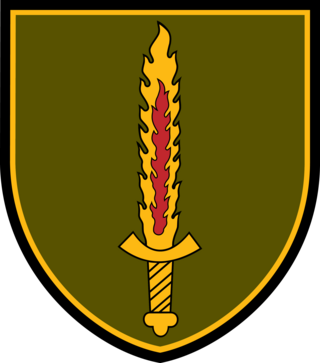
The Lithuanian Special Operations Forces (LITHSOF) (Lithuanian: Lietuvos Specialiųjų Operacijų Pajėgos) is a special operation unit of the Lithuanian Armed Forces, formed exclusively of carefully selected, motivated and specially trained professionals. The main tasks of the Special Operations Force are direct action, special reconnaissance, and military assistance.

RKL(Lithuanian: Regionų krepšino lyga, English: Regional Basketball League) is a third Lithuania basketball league. Regional Basketball League started their activity in 2005. RKL consists of 32 basketball teams from 28 Lithuania cities. Regions divided to four groups: Aukštaitija, Žemaitija, Suvalkija and center of Lithuania. Each group has eight basketball teams. In the 2006-2007 RKL season, there was some differences as the regions was divided to two groups: East and West of Lithuania and the number of participants was 28. There is B Division of RKL, which is the 4th tier basketball league of Lithuania.
The Lithuanian A Lyga 2007 was the 18th season of top-tier football in Lithuania. The season started on 7 April 2007 and ended on 10 November 2007. 10 teams participated with FBK Kaunas winning the championship.

















